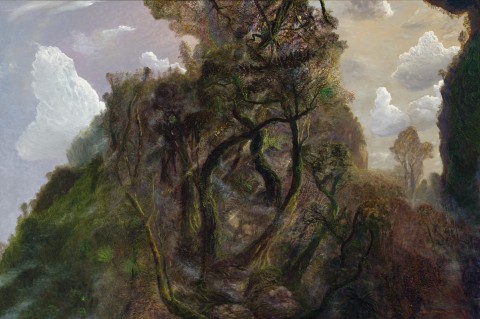MIST IN THE AFTERNOON SUNLIGHT, 2002
WILLIAM ROBINSON
oil on linen
122.0 x 183.0 cm
signed and dated lower right: William Robinson 2002
inscribed twice with title verso: MIST IN AFTERNOON SUNLIGHT
Australian Galleries, Sydney (label attached verso)
The Laverty Collection, Sydney, acquired from the above in 2002
William Robinson: Recent Paintings, Australian Galleries, Sydney, 13 August – 7 September; Melbourne, 24 September – 25 October 2002, cat. 4 (label attached verso, as ‘Mist in Afternoon Light’)
Rainforest Mist in Afternoon Light, 2002, oil on canvas, 167.0 x 244.0 cm, private collection, Brisbane, illus. in Hart, D. (et. al), William Robinson. The Transfigured Landscape, Queensland University of Technology and Piper Press, Brisbane, 2011, p. 127
When William Robinson came to create Mist in Afternoon Sunlight, 2002, he was well established as a great Australian landscape painter. With four of Australia’s most prestigious art prizes to his name (two Archibald and two Wynne prizes) as well as thirty solo exhibitions, the artist had every right to feel comfortable with the mantle. When it came to painting the Australian landscape many artists of Robinson’s generation chose to look inwards towards the outback’s desperate beauty, while Robinson focussed almost entirely on the ancient rainforests and eucalypt forests of southeast Queensland.
As the years have passed Robinson’s work has taken on a more spiritual tone. Gone are the whimsical farmyard scenes, where the chickens, geese and goats mischievously mirrored the politics and hierarchies of the local Brisbane art scene. However, those important formative works alerted Robinson to the possibilities of altered perspectives and alternate approaches to conventional horizons. Many of his mature works feature aspects of the weather as subject matter, sunlight, mist, cloud fronts. These ephemeral forces of nature override creatures in the landscape and celebrate creation as the work of a higher power.
Similar to the larger, closely related Rainforest Mist in Afternoon Light, 2002, the landscape of this work might resemble the Tower of Babel as Robinson’s twisting escarpment climbs its way toward the heavens. Upwards and outwards the foliage and trees writhe and swirl. White cumulus clouds loom large or drift in the distance. The eastern side of the escarpment is lush and green, while the western side is rich in violets and warm earth tones. As the sun lowers in the west, it highlights the trunks of the trees, which split the light into rays. The late afternoon mist drifts up and around the ancient landforms, while shafts of sunlight beam through the trees and catch the mist – affording the work its lyrical title.
By the time of his Sydney and Melbourne Australian Galleries exhibitions in 2002 (which included the present work), the artist’s trademark staccato brush work had given way to a more contemplative, patient method of applying the paint. The urgency to capture the moment and draw it to a towering crescendo had given way to a rhetorical meditation on the painting itself.
Robinson’s paintings attempt to create the sensation of being in the landscape, as the artist explains: ‘I want to move away from observing the picture as some sort of representation. I want to sweep the observer down gullies and up into the sky. The observer is drawn into the landscape not physically but as a sort of connection to memory. The painting reminds us of experiences we might have had when walking in the bush… I am only presenting personal experience to be shared, but I would like to give some clues that may help the observer to experience the picture.'1
1. Seear, L., Darkness and Light, The Art of William Robinson, Queensland Art Gallery, Brisbane, 2001, p. 118
HENRY MULHOLLAND
